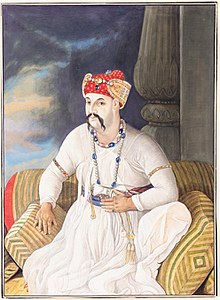List of Mughal grand viziers
Grand Wazir of the Mughal Empire From Wikipedia, the free encyclopedia
The Grand Vizier of Hindustan (Hindustani: Vazir-ul-Mamlikat-i-Hindustan)[1][2] was the highest ranking minister in the Mughal Empire and the chief adviser to the emperor himself. The position acted as the de facto head of government of the Mughal Empire and had responsibility for leading the ministers of the Empire. This is the list of grand viziers (vazīr-e azam) of the Mughal Empire.
| Grand Vizier of Hindustan | |
|---|---|
| Appointer | Mughal emperor |
| Formation | 21 April 1526 |
| First holder | Amir Nizamu-d din Khalifa |
| Final holder | Asaf-ud-Daula |
| Abolished | 21 September 1797 |
History
Summarize
Perspective
The seniormost official under the Mughals, or the Prime Minister, held different titles such as Vakil, Vakil-us-Sultanat, Wazir, Diwan, Diwan-i-Ala and Diwan Wazir under different Mughal emperors.[3] Under Babur and Humayun, the institution of the wazirat was not fully developed owing to a lack of an entrenched nobility and political upheaval. Nonetheless, individuals under both rulers did rise to positions equivalent to the position of prime minister and under Humayun reforms were first attempted to clarify the roles of Vakil and Wazir.[3]
In the early years of Akbar's reign, the position of prime minister was first officially held by Bairam Khan as Vakil-us-Sultanat, and he exercised considerable influence over the emperor. Over time the power of the Vakil gradually declined, and during the reign of his successor Jahangir the role of Wazir replaced the Vakil as the most important officer in government.[3] Mughal wazirs were specifically appointed from the ahl-i-qalam(men of the pen) as distinct from the ahl-i-saif(men of the sword).[4] With the abolishment of the post of Wakil, the post was divided into the two offices of Wazir and Mir Bakhshi, where the chief Wazir was the head of the finance department, while the Mir Bakhshi was the head of the military department.[5] These two offices were made jointly responsible for the administration by a system of signatures and counter-signatures.[6] Until the death of Aurangzeb, the post of Wazir was never a threat to the monarchy as the Wazir could not act too independently. However, after the death of Aurangzeb, the pre-mughal tradition in India of the Wazir being the premier noble at the court and leading counsellor of the king apart from being the head of the financial administration had been re-established.[7]
List of grand viziers
Summarize
Perspective
| Portrait | Name | Term of office | Notable events | Emperor | |
|---|---|---|---|---|---|
| Amir Nizamuddin Khalifa | 21 April 1526 | 17 May 1540 | 1st Battle of Panipat | Babur (1526 – 1530)
& Humayun (1530 – 1540) | |
| Qaracha Khan | 1540 | ? | He was a governor of Qandahar and Humayun appoint him as Grand-Vizier of the Mughal State. | Humayun (1530 – 1556) | |
 |
Bairam Khan[3] | 1556 | March/April 1560 | Akbar-i-Azam اکبر اعظم (1556-1605) | |
 |
Munim Khan | 1560 | 1561 | ||
| Ataga Khan[8] | November 1561 | 16 May 1562 | He was assassinated by Adham Khan | ||
| Muzaffar Khan Turbati[9] | 1575 | 1579 | No Vakil was appointed after his appointment to governorship in Bengal from 1579 until 1589 | ||
 |
Abu'l-Fazl ibn Mubarak[10] | 1579 | 22 August 1602 | ||
| Sharif Khan[3] | 1605 | 1611 | Jahangir جہانگیر (1605-1627) | ||
 |
Mirza Ghias Beg[3] | 1611 | 1622 | ||
 |
Abu'l-Hasan Asaf Khan[3] | 1622 | 1627/28 |
| |
 |
Shaikh Ilam-ud-Din Ansari[11] | 1627 | 1628 (less than a year) | Shah Jahan شاہ جہان (1628-1658) | |
| Azam Khan[12] | 1628 | 1628 | |||
 |
Afzal Khan Shirazi[3] | 1628 | 1639 | ||
 |
Islam Khan Mashadi[3] | 1639 | 1645 | ||
 |
Sadullah Khan[13] | 1645 | 1656 |
| |
 |
Mir Jumla[14] | 1656 | 1657 | Alamgir I عالمگیر (1658-1707) | |
| Jafar Khan[15] | 1657 | 1658 | |||
| Fazil Khan[15] | 1658 | 1663 | |||
| Jafar Khan[14] | 1663 | 1670 [16] | |||
 |
Asad Khan[17] | 1675 | 1707 | ||
| Mun'im Khan Khan-i-Khanan[18] | 1707 | 1711 | Bahadur Shah I بہادر شاہ (1707-1712) | ||
| Hidayatullah Khan Kashmiri[19] | 1711 | 1713 | Jahandar Shah جہاندار شاہ (1712-1713) | ||
 |
Zulfiqar Khan Nusrat Jung[20] | 1712 | 1713 | ||
| Mir Rustam Ali Khan[3] | 1710 | 1737 | Farrukhsiyar فرخ سیر (1713–1719) | ||
 |
Qutb-ul-Mulk Abdullah Khan Barha[21] | 1713 | 1720 |
| |
 |
Muhammad Amin Khan Turani[21] | 1720 | 1721 | Muhammad Shah محمد شاہ (1719-1748) | |
 |
Mir Qamar-ud-Din Khan Asaf Jah I[23] | 1721 | 1723 | ||
 |
Roshan-ud-Daulah Zafar Khan[24][25] | 1724 | 1733 | ||
 |
Mir Fazil Qamar-ud-Din Khan | 1733 | 1748 | ||
 |
Safdar Jang[23] | 1748 | 1753 | Ahmad Shah Bahadur احمد شاہ بہادر (1748-1754) | |
| Intizam-ud-Daulah[26] | 1753 | 1754 | |||
 |
Imad-ul-Mulk Feroze Jung[26] | 1754 | 1760 | Alamgir II عالمگیر دوم (1754-1759) | |
 |
(de-facto wazir-i-azam
(Original shahjada-wazir-i-azam |
1760
1760 |
1775
1784 |
Shah Alam II شاہ عالم دوم (1760-1806) | |
| Najaf Quli Khan[28] | 1772 | 1791 | |||
See also
References
Wikiwand - on
Seamless Wikipedia browsing. On steroids.

